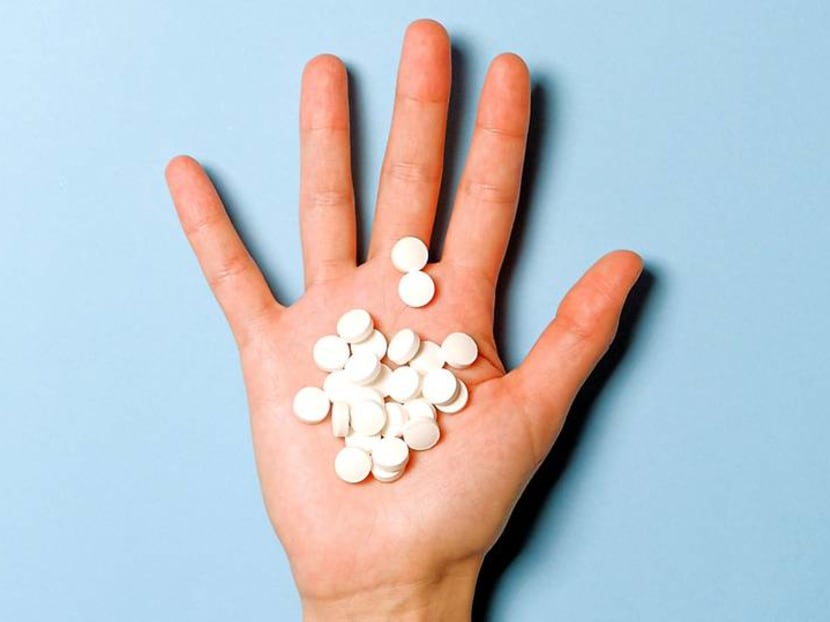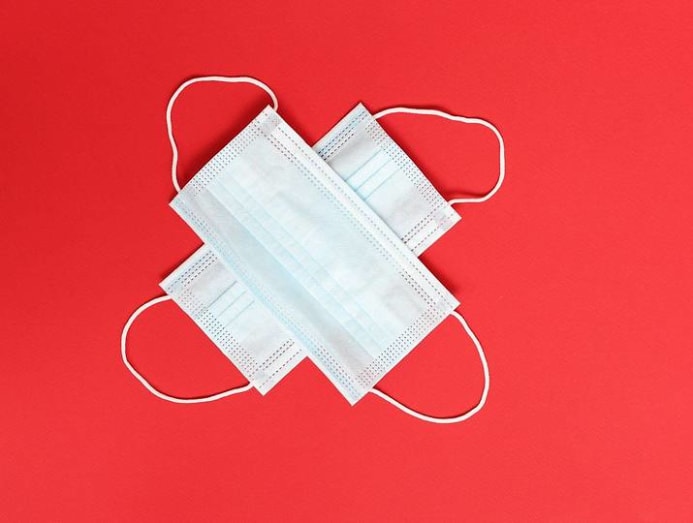Pain, pain, go away: Why you shouldn't take over-the-counter painkillers lightly
Other than allergic reactions (yes, even from paracetamol), you can also increase your risk of liver damage. CNA Lifestyle looks at the different misconceptions regarding painkillers.

(Photo: Pexels/Anna Shvets)
People use painkillers – both over-the-counter and prescribed – for reasons that range from everyday situations (headaches, fever, menstrual cramps, arthritis and musculoskeletal aches) to specific ones (nerve damage, trauma injuries and surgery).
And it’s not only paracetamol (commonly sold under Panadol) that is available on the shelves and first in line for doctors to prescribe, said general practitioner Dr Jonathan Ti from DTAP Clinic Robertson. There are also non-steroidal anti-inflammatory drugs (NSAIDs), which include ibuprofen, aspirin and naproxen, which are sold under brands such as Nurofen, Alka Seltzer and Aleve respectively.
At the polyclinics, the commonly prescribed painkillers include paracetamol, paracetamol combined with a muscle relaxant, and NSAIDs, said Christina Lim, the assistant director of pharmacy at SingHealth Polyclinics. Another option is paracetamol combined with low-dose codeine (an opioid painkiller) but it is only available after a pharmacist's assessment, she said.

While there are no topical paracetamol products available in Singapore, there are NSAIDs available as gels or patches. These include ketoprofen gels (under brands such as Fastum) and plasters (under the Kenhancer brand), said Lim.
Speaking of topical painkillers, there are also the counter irritants and local anaesthetics, which you can get without a prescription, said Yong Pei Chean, the president of the Pharmaceutical Society of Singapore (PSS), on behalf of the PSS team.
READ: Headaches: When should you take a painkiller or see a doctor?
Counter irritants (under brands such as Tiger Balm and Ammeltz Yoko Yoko) generally contain ingredients such as capsaicin, menthol and camphor. After applying on the skin, a warm or cool sensation can be felt, which distracts you from the actual pain, she explained.
On the other hand, local anaesthetics, such as lignocaine, can be found in antiseptic creams and gels. “When these are applied, it temporarily numbs the area and reduces the ability of nerves to transmit pain sensation,” said Yong, who is also the pharmacy head of the upcoming Woodlands Health Campus.

Now, because painkillers are so readily available – even minors who can’t buy alcohol and cigarettes can access them – there’s a greater likelihood for people to regard them lightly. Here’s a look at some of the common misconceptions about over-the-counter pain relief and how these can actually work against you.
MISCONCEPTION #1: IBUPROFEN WORSENS COVID-19 SYMPTOMS
If you’ve been following the news, you’d have come across reports on NSAIDs, specifically ibuprofen, worsening the symptoms of COVID-19 infections such as fever. “In early March, health authorities in France put out a warning on the use of ibuprofen in patients with COVID-19 based on unconfirmed anecdotal reports that severe COVID-19 cases had been exposed to this medication,” said Dr Ti.
READ: Born in the 70s or 80s? Your vaccination jabs might have expired
“However, numerous studies and analyses have since been done with ibuprofen and other NSAIDs, which demonstrate there is no increased risk for people using NSAIDs to develop a more severe COVID-19 infection in comparison to those taking paracetamol, or other painkillers or fever medications,” he said.
The issue has also been addressed by health organisations, including the World Health Organization and the Ministry of Health in Singapore.

Dr Koh Kim Hwee, the clinical lead for SingHealth Polyclinics' Musculoskeletal Workgroup, said that on the whole, "ibuprofen is still a safe and useful painkiller, and it may be used as an option in treating fever and/or pain in patients with suspected or confirmed COVID-19". "As with other NSAIDs, the lowest effective dose should be used for the shortest period required to control the symptoms if needed."
In fact, NSAIDs can be your alternative if you are allergic to paracetamol, said Yong. As the name indicates, this category of drugs relieves pain by reducing swelling, redness and warmth. In addition to ibuprofen and naproxen, NSAIDs also include diclofenac, mefenamic acid, celecoxib and etoricoxib.
But unlike paracetamol, which is generally better tolerated, NSAIDs may not be suitable for everyone.
“NSAIDs are known to have some blood-thinning effects and may increase one’s risk of bleeding, especially when it is taken together with medicines or herbal supplements that have similar properties,” cautioned Yong, referring to the blood thinner warfarin, and herbs such as ginkgo and ginseng.
You should also check with your doctor first before popping NSAIDs if you are under 16 or over 65 years old, pregnant or trying for a baby, breastfeeding, asthmatic, had previous stomach ulcers or allergies to NSAIDs, have problems with the heart, liver, kidneys, blood pressure, circulation or bowels, and/or taking other medicines, noted the National Health Service (NHS) in the UK.
NSAIDs are usually taken once or twice a day and the tablets should be swallowed whole (not crushed or chewed, unless otherwise told by your doctor) and taken after food to prevent stomach upset, advised SingHealth.
MISCONCEPTION #2: IT’S OKAY TO TAKE PAINKILLERS WITH OTHER MEDICINES
Unknowingly overdosing on painkillers can happen when you are not aware of, or are unfamiliar with the ingredients in the medicine.
“For instance, a patient may be taking Anarex, which contains paracetamol and orphenadrine, for chronic pain. If he purchases Panadol Cold Relief (it also contains paracetamol as well as phenylephrine) to self-medicate and relieve symptoms of the flu, he could unknowingly be overdosing on paracetamol,” said Yong.
READ: Over-the-counter cough mixtures: Do they actually work better than tea and honey?
“This frequently occurs when medications are obtained from different sources, such as when they are prescribed by two different doctors or pharmacists.”
Overdosing can also occur when you aren’t aware of the painkiller’s strength, which happens very commonly in children, said Yong.
“A child may be previously prescribed with 5ml of a 120mg/5ml preparation by a doctor. Should the parent subsequently purchase a 250mg/5ml preparation and give the child 5ml as per the previous doctor’s prescription, the child will be given double the dose.”

In the first place, getting the dose right for children can be tricky as it is more accurately determined based on the child’s weight, said Yong. “However, weight-based dosing information may not always be present on the packaging. Furthermore, patients who are underweight, elderly, or have existing kidney or liver problems, are also at a higher risk of overdose.”
MISCONCEPTION #3: TAKE A LITTLE MORE TO SUBDUE THE PAIN FASTER
It doesn’t work that way, said Dr Ti. “Different medications will have different onset and duration of action timings. Oral paracetamol and ibuprofen generally start working within 30 minutes, and effects last about six to eight hours.”
The same medicine can be formulated differently and that can also affect the duration of action, said Yong. For example, diclofenac’s sustained release may last for up to 24 hours and is taken once a day, while diclofenac immediate-release tablets can last only eight to 12 hours, and may be taken two or three times a day.
Moreover, taking more painkillers than you should can wreck your liver. For instance, you should not exceed eight 500mg tablets of paracetamol in a day, according to Yong. Over-dosing and liver injury can also occur with just a single ingestion of 10g or 200mg per kilogram of your body weight (whichever is less) within an eight-hour period, even without long-term consumption.
“For paracetamol overdose, symptoms may include nausea, vomiting, sweating, and changes in mentation (mental activity),” said Dr Ti.

The signs of overdosing on NSAIDs are more severe, including acute kidney injury and/or bleeding in the stomach or intestines, said Yong. “This bleeding may present as nausea and vomiting, blood in the vomit, or as black, sticky stools with or without sharp gastric pain.”
The long-term use of NSAIDs is also associated with long-term stomach pain, ulcers in the stomach and intestines, and can increase the risk of heart disease, she said.
If you suspect an overdose, head straight for the hospital emergency centre, advised Dr Ti. “They will require specific treatment protocols and close monitoring, which would not be available at a regular GP.”
“It can be helpful to bring along the box or leaflet of the medication the patient has been taking to help the medical team accurately identify the cause of the overdose,” suggested Yong.
MISCONCEPTION #4: IT’S JUST A PAINKILLER. NO HARM CAN COME FROM TAKING IT
Not true as some individuals can be allergic to paracetamol. For instance, if you notice reactions such as rashes, swelling of the eyes and lips, and/or difficulty breathing after taking paracetamol, stop and see a doctor immediately.
You might also want to avoid paracetamol if you regularly drink more than 14 units of alcohol per week, have kidney or liver problems, and/or are on epilepsy medicine, according to the NHS. In fact, some medications may even interact with food, said Lim, so it's best to consult a pharmacist or doctor before starting on any new medication, even if it is an over-the-counter one.

NSAIDs, on the other hand, may cause common side effects such as dizziness, nausea, gastric irritation and increased blood pressure, according to SingHealth. You should also look out for the less common side effects such as fluid retention and/or worsening asthma.
When it comes to the dosage, take your cue from the packaging, especially for NSAIDs, as their dosages differ. For paracetamol, SingHealth recommended one to two tablets, three or four times daily for patients who are 12 years old and beyond. Do not take more than two tablets at any time and ensure each dose is at least four hours apart.
What if you have to regularly take paracetamol and miss a dose? Take it as soon as you remember, advised the NHS. You can skip the missed dose if it's nearly time for your next dose. However, do not take an extra dose to make up for a missed one. The same applies to NSAIDs, too.
“When in doubt, it is advisable to consult the doctor or pharmacist for advice,” said Yong. “This is especially important if one has any medical conditions, is on long-term medication, pregnant, or breastfeeding.”





